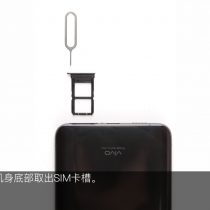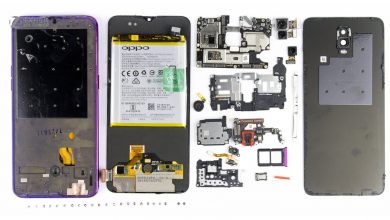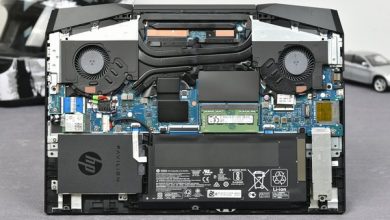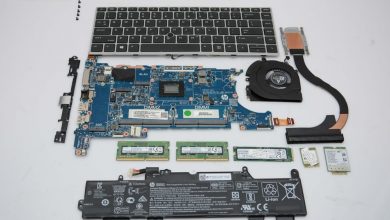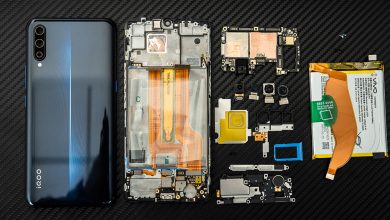On June 12, 2018, Vivo has held a new product conference to officially launch its dual-camera phone – the Vivo NEX. This phone features a 6.59-inch super large OLED screen without fringe with a resolution of 2316 pixels by 1,080 pixels. Besides, it also supports the third generation under-screen fingerprint scanning technology. Now, we have got the Vivo NEX. Let’s start the teardown of this phone to see its workmanship and internal design.
First of all, remove the SIM card tray from the bottom of the phone. The surface of the SIM card tray uses plastic material, and its interior part is made of metal. In this way, the card can be both flexible and hard. Besides, the card tray is designed with the rubber ring which is used to prevent vapor from entering.
No screw is placed at the bottom of the phone body. Therefore, we first heat up the back cover to make the glue less sticky. And then, use a sucker to remove the back cover. As a result, the screen is removed instead of the back cover, which surprises me a lot. After taking out the screen, we find no screw inside.
We find new technology under the screen. The first technology is the third generation under-screen fingerprint reader. There is only a hole found on the back of the screen. From that, we realize that the under-screen fingerprint reader that the NEX comes with is different from the Vivo X21’.
A camera module with special design is right below the fingerprint reader. The phone utilizes this super short-focus camera to capture the user’s fingerprint information via the screen. Except for the fingerprint under the screen, the aperture on the top of the screen also makes me curious. This is the under-screen light sensor. It is widely known that the OLED screen transmits light. The larger the light sensor’s volume is, the more sensitive the light sensor becomes towards the light.
As I fail to remove the back cover with a sucker, I have no choice more to use a more violent way to remove the back cover. Heat up the back cover, and then insert a knife into the back cover and the phone body to successfully remove the back cover without destroying the appearance of the phone.
After removing the back cover, we can see that the phone inside adopts a three-stage design. As the SIM card tray is placed at the bottom of the phone, the bottom part occupies much space. The motherboard on the top is covered by a large plate. Although the camera is eye-catching, I still decide to take out the motherboard first and to figure out its structure. Therefore, I first disconnect the cable of the battery. And then, disconnect the cables of the button nearby and the vice board at the bottom.
The shield cover on the front of the motherboard is covered with a layer of copper foil which can help heat dissipation. After uncovering the copper foil, several bare small components can be seen. However, the big shield cover can’t be removed. After removing the shields on the surface, the Samsung K3UH7H7 8GB LPDDR4 memory chip can be seen in the middle. The Qualcomm Snapdragon 845 mobile platform is below the memory chip. The flash is hidden in a shield near memory chip, so we can’t see it. This is the vice camera. This camera supports four-axis optical image stabilization function.
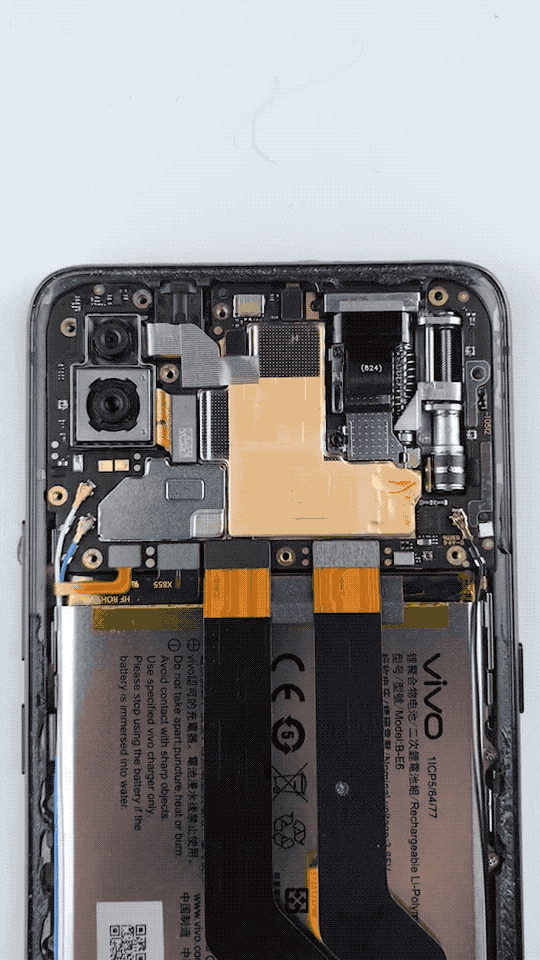
It is the gif image of how spring principle works. The spring design functions as a cushion to outer forces on the camera. But in fact, it is the spiral stepper motor on the right that propels the whole progress work. We can see the two sides of the stepper motor. The cost of this module is high. Although the front camera is not motivated by the motor, it can freely still slide upwards or downwards. These are all the components that I get from the front camera of the phone.
The component which looks like a linear vibrator is the phone’s earphone. Vivo claims that this component is a key to make the screen make a sound. From that, we can see that it is totally different from piezoelectric ceramics acoustic that the Xiaomi MI MIX. However, their acoustic principle is the same.
From the seal cover, we can infer that the cost of this vibrator unit is high. The vibrator makes it possible for the user to hear clear sound when close to the screen even no aperture is designed on the earphone. Besides, compared with piezoelectric ceramics acoustic, this design can bring more excellent sound.
The battery is fixed in a different way. The battery is fixed on the metal base, and the base is fixed by six screws. So I need to take out six screws first before removing the battery. When I first see the package of battery, I have thought that its supplier is Sony because I have seen similar package before when tearing down the Sony XZ2. The Vivo NEX sports a super large 4000mAh battery with the capacity of 15.4Wh and it supports 22.5W flash charge technology. From the back of the battery, we can see that its supplier is ALT.
As I have already taken out the earphone, and this is the back of the loudspeaker. The supplier of this loudspeaker is unknown. Besides, we can see that a chip area on the front of the vice board is protected by the shield cover. The microphone and data port have also been integrated there. The next is screen module.
Summary

After the teardown, we can see that Vivo has applied many new technologies to the NEX. More importantly, even though the phone’s internal structure is complicated and more apertures are designed on the phone body, it still has good waterproof and shatter-resistant functions. The NEX has good workmanship. Besides, the phone uses good quality material and it has good heat dissipation performance.


